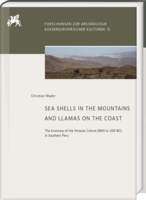|
|
more titles of the subject:
Download:
The research presented in this volume reconstructs the economic system of the Paracas culture (800-200 BC) in southern Peru. In doing so, the main emphasis is on economic exchange at the western slope of the Andes, with the Late Paracas period (370-200 BC) in the Palpa valleys (Andean Transect) serving as a case study. For this archaeoeconomic approach, Jauranga (285 m.a.s.l.), Collanco (1.630 m.a.s.l.), and Cutamalla (3.300 m.a.s.l.) – where extensive excavations were conducted by the Palpa Archaeological Project of the German Archaeological Institute – are the most important sites. The work is based on analyses of excavated materials, particularly obsidian artifacts, malacological finds, and camelid bones. Therefore, various methods including archaeometric techniques, quantification, artifact classification, and species determination are combined.
The results show exchange processes in the western Andes that are characterized by unbalanced commodity flows. Resources from the highlands such as obsidian, camelids and their products arrived at the Pacific desert strip in large amounts, while marine resources such as sea shells reached highland regions only in small amounts. Raw materials were not just procured in the mountains, there were also strategic production centers like Cutamalla. All in all, consumption at coastal settlements like Jauranga needs to be seen as the driving force behind the Paracas economy. |






